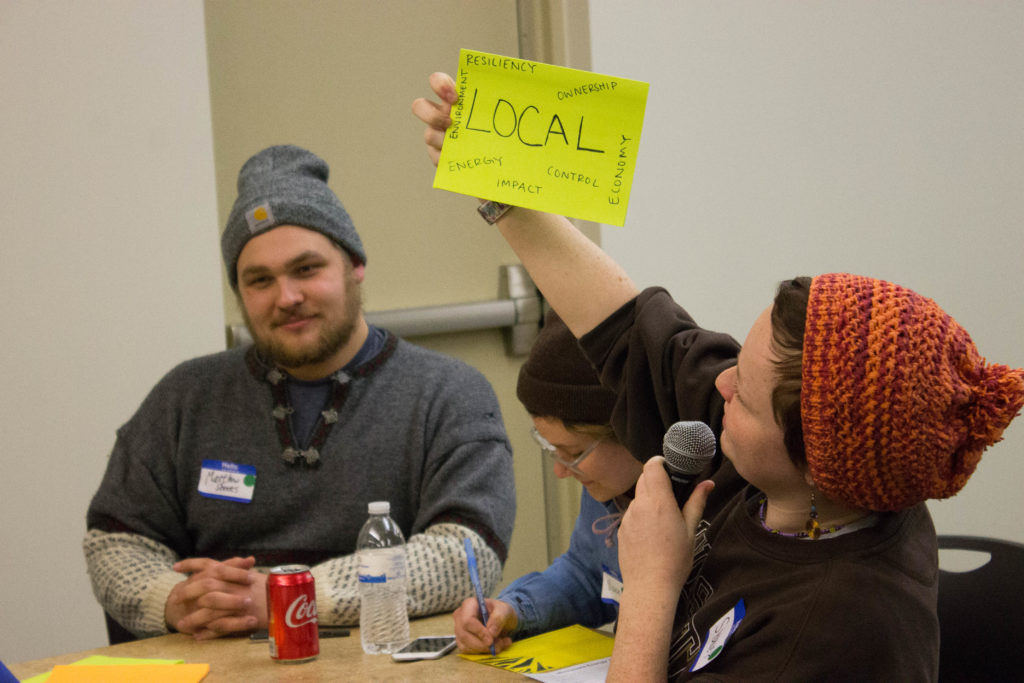This blog is part of an ongoing series where we interview community members, experts, and partners that have participated in our projects. Sydney Bauer, a junior at the University of Minnesota Morris and intern at the campus sustainability office, shares her experiences at “Our Energy Future: Stevens County”
When I began my internship at the University of Minnesota Morris (UMM) Office of Sustainability two years ago I did not understand the difference between a kilowatt and a kilowatt-hour. I was new to the energy world and my limited vocabulary showed that. I spent the next two years collecting and analyzing data on the UMM energy grid. I wanted to find out where our energy came from, calculate how much it cost, graph energy demand trends, and most importantly build relationships with the people who maintained our small but complex grid. After spending two summers working full time in the office my energy literacy has improved and my passion for renewables has shifted my career goals to include sustainability and energy focused work here in rural Minnesota.
On December 6th I was grateful to attend “Our Energy Future: Stevens County” a dialogue event hosted by The Jefferson Center and The Institute for Agriculture and Trade Policy. I was excited to hear from Mike Reese, the Renewable Energy Director of the West Central Research and Outreach Center (WCROC), from Brian Draxten, an Ottertail Power Company(OTPCO) Resource Planner, and from Blaine Hill, the Morris City Manager, on how they each viewed the Stevens County energy transition. Mike discussed our local opportunities including energy audits, efficiency upgrades, battery storage, and local production ownership. Brian helped us understand the complexity of running a smaller power company across multiple states and informed us of OTPCO’s increasingly clean energy sources. Blaine finished up the presentations by telling the audience about the “most exciting thing he has done in his 30-40 years working in local government”: the technical partnership between the City of Morris and Saerbeck, Germany. His presentation truly showcased the motivation Blaine has to tackle big projects and change the mindset around energy in Stevens County.
Although I thought the presentations at the event were illuminating, I had also been particularly looking forward to hearing how others in my community viewed and understood energy. It was extremely exciting to see and hear from the many different people who attended the event, including students, families, professors, farmers, legislators, active community members, and city officials. My community sat together in small groups, moving between tables every few minutes, and discussed the following questions:
- “What interests or excites you most about the future of our energy system?”,
- “What concerns do you have about the way our energy system might change?”
- “What do you think Stevens County’s energy system should look like in 10 years?”.
The answers varied from group to group and question to question, but overall a common theme emerged: local growth. Whether that be in our local economy, our local energy literacy, our local renewables production, or our local intellectual capital, people truly wanted to see Stevens County utilize its unique combination of resources to generate local growth. It was inspiring to me to see that many people who had not discussed these things together in the past had uncovered shared energy goals. Simply by answering a few quick questions, the people of Stevens County were united in their aspirations and started to build a team of renewable energy enthusiasts.
When I think about where I want the conversations around energy to go from here, I usually think about specifics. I ask myself, how can Stevens County actually achieve these local growth goals? Should we install more wind turbines? Do we organize a solar garden? And finally, how will we know what specific steps are right for us and our community?
One challenge to our energy future highlighted by a community member at my table was, “finding complex answers to complex problems”. I think this statement highlights perfectly where I believe our energy conversations should go from here. We must start thinking about how we can answer these complex questions and problems. Questions like, what groups are willing to dedicate the time and money to do community outreach surrounding these issues? Who shall be tasked with the background research of understanding our actual energy usage in Stevens County? In Morris? Where can we go to learn more about local energy production and the policy and technology behind it? I believe that taking the time to figure out how and when we will answer these complex questions is a wonderful step forward in our energy conversations!
I am excited to continue this dialogue with my community and put my time and energy into developing an energy future that promotes our sustainable, local growth!



